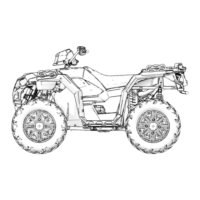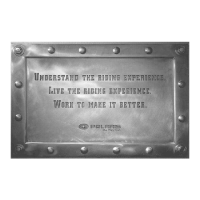4.24
ELECTRONIC THROTTLE CONTROL
ETC OVERVIEW
NOTE
Only some models will be equipped with ETC, others
will have the standard cable controlled system.
NOTE
DO NOT attempt to service the ETC. The ETC is a non-
serviceable component and can only be tested using
Digital Wrench®. If the ETC is faulty, the entire
assembly must be replaced.
Mounted to the intake, the ETC acts as an electronically
controlled throttle body. The ETC controls engine throttle
operation to provide the proper air/fuel ratio needed for
engine operation at all RPM ranges. The ETC controls
engine RPM based off input provided by the Throttle
Control Sensor (TCS) and Electronic Control Unit (ECU).
ETC TEST
Never attempt to disassemble the ETC assembly.
Warranty is void if the end cover is opened or tampered
with in any way.
All operating and control functions within the ETC are
pre-set. No internal servicing or adjustments may be
performed. If a problem is encountered, and you
determine the ETC to be faulty, contact the Polaris
Service Department for specific handling instructions. Do
not replace the ETC under warranty without factory
authorization.
Use Digital Wrench® to perform all troubleshooting of
this component. Use a Volt Ohm meter to test the vehicle
harness continuity between the ETC connector and ECU
connector. Refer to the wire diagram for pin-out details. If
the ETC is faulty, the entire ETC assembly must be
replaced.
ETC REPLACEMENT
1. Remove the intake air box.Intake Replacement, page
3.25
2. Disconnect the wire harness from the ETC.
3. Depressurize the fuel system at the fuel valve.
Disconnect the fuel line fitting from the fuel rail.
4. Remove the 4 bolts retaining the ETC housing to
intake .
5. Reverse these steps for installation. Torque the ETC
housing retaining bolts and intake runner screws to
specification.
TORQUE
ETC Housing Retaining Bolts:
7 ft-lb (10 Nm)
Plenum to Throttle Body Fasteners:
7 ft-lbs (10 Nm)
FUEL SYSTEM

